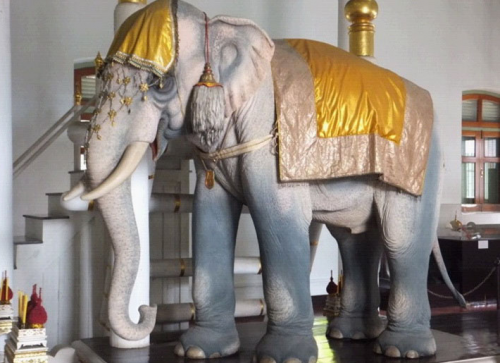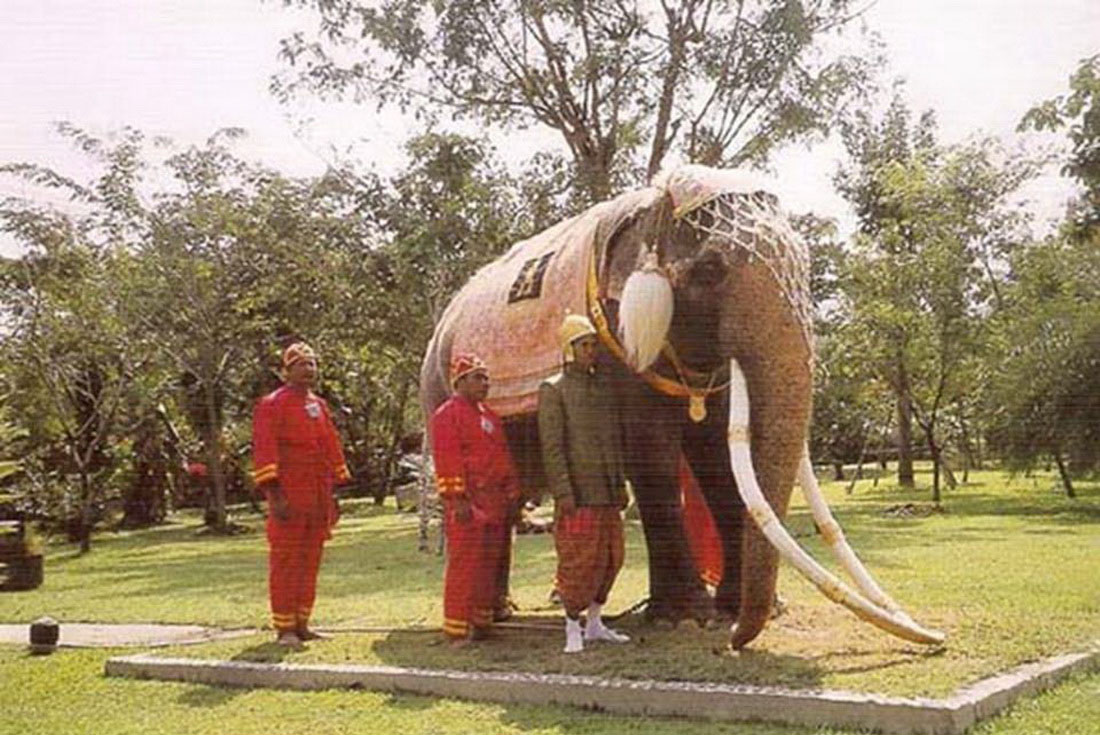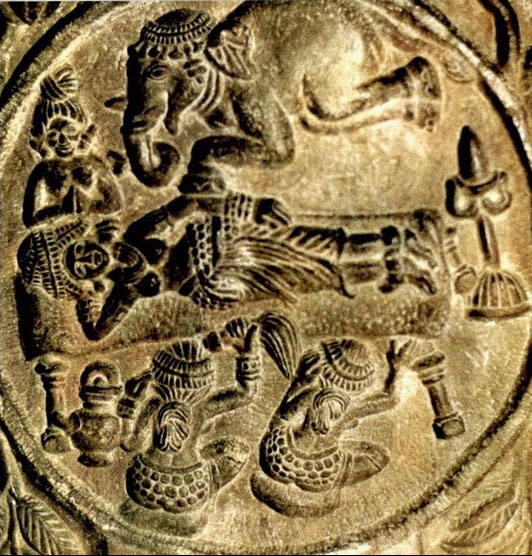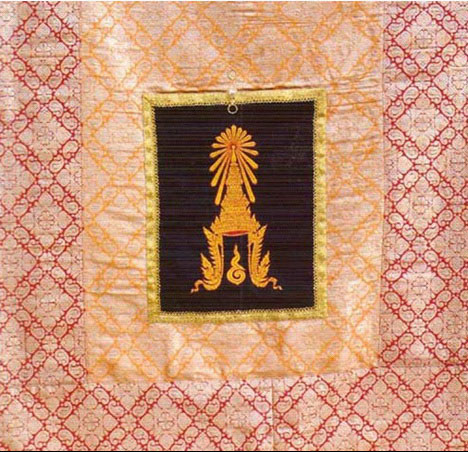The ‘Gajabhorn’of Phra Sawet Adulyadejpahon: ornament of King Rama IX’s first white elephant
Lalita Assawasagulrecha*
Image1. Phra Sawet Adulyadejpahon adorned with ‘Gajabhorn’ in 2006.
The elephant has had a long history of respect and importance in Thai society, particularly in the Thai royal court. This is especially true of white elephants, which are rare and have several unique attributes.
Countries in Southeast Asia have inherited their belief in the blessings of the white elephant from India. A white elephant has significant characteristics; it is believed that they can bring auspicious favors to their owners and, in a city which acquires a white elephant, the king is regarded as both meritorious and powerful.
This piece of Ancient Indian art, a Buddhist stone relief, shows the adornment of an elephant.
A White elephant is included as one of the seven auspicious imperial gems called "Sapta Ratna”, which are symbols of the king. These gems are as follows: a circle (Chakra), a precious stone (Mani), a lady (Naung), a financier, a warlord, a horse and an elephant. An occasion of an important royal ceremony accompanied by an elephant in Thailand is a grand celebration.
In ancient times, whenever a white elephant was discovered, it would be offered to the king. The king would hold a grand celebration for the elephant and appoint it as Chao Phraya, Phraya or Phra. Then, the royal elephant was given an ornament or ‘Gajabhorn’. The nature of the ornament depended on the elephant's title.
According to the Royal Institute Dictionary in 1999, the meaning of ‘Gajabhorn’ is an 'ornament of a Royal elephant'. The word is created by two Pali words – Gaja, meaning 'elephant' and abhorn, meaning 'ornament'. Gajabhorn refers to the regalia given by the king to a royal elephant in a grand celebration. The differences in the ornaments given depend on the royal elephant’s status and the king’s intention.
In general, the practice of elephant-adorning in Thailand and neighboring countries has been influenced by the religious beliefs of India. Many artifacts from the Ayutthaya period reflect these beliefs, such as the early-Ayutthaya period elephant, adorned in gold from Wat Ratchaburana; and a stucco-adorned elephant from the same period, found on the base of a stupa at Wat Changrob in Kampaengphet.
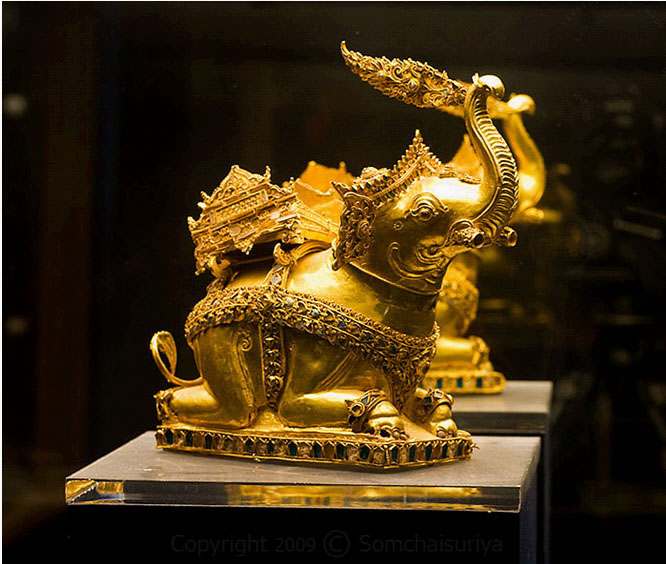
The early Ayutthaya art golden adorned elephant from Wat Ratchaburana
This early Ayutthaya-period, stucco adorned elephant is a decoration at the base of a stupa at Wat Changrob
There is much evidence of a relationship between Ayutthaya and France where elephant ornamentation was concerned, particularly during the reign of Narai The Great. For instance, the Royal Ayutthaya Chronicle mentioned that Narai The Great ordered Kosa Pan to buy elephant ornaments from France; also, a painting by a French artist shows Narai The Great sitting on a throne atop the royal elephant.
In the Ratthanakosin era, the belief in white elephants as an auspicious symbol was inherited from Ayutthaya era, and due to this, ornaments were made during every reign in this era. The elephants’ ornaments were presented and worn in all royal ceremonies, such as the royal coronation and the commemoration of the king’s birthday.
The elephants for whom ‘Gajabhorn’ are made can be divided into 3 types, as follows:
- White elephants (Changpeuk): The elephants have all of the important physical attributes outlined in the chapter on elephants’ characteristics. Their ornaments are made from gold, precious stones and glass.
- Important elephants (Changsamkun): The elephants have some of the important physical attributes outlined in the chapter on elephants’ characteristics. Their ornaments are made from niello, on a copper base.
- War elephants (Changsek): The elephants are trained for and guided by humans in combat. Their ornaments are made from gilded brass or silver.
However, since the reign of King Mongkut, the war elephants have become less important and, indeed, necessary than they were in the past, as engagement in warfare has decreased. Nowadays, in the reign of King Rama IX, there are only white elephants and important elephants. The first royal white elephant of King Rama IX is Phra Sawet Adulyadejpahon who was captured in Krabi in 1954. The reception and commission ceremony was held on November 11, 1959.
The elephant-ornament building usually occurs only one time during any reign. In the Ratthanakosin era, however, in the reign of King Rama IX, two ornaments were built for Phra Sawet Adulyadejpahon. The first was built in 1959 in the grand celebration for the elephant, when it was young. The second was built in 2006, when the royal elephant grew up and the old ornament no longer fitted. They were both made of gold, precious stones and glass, as for any royal white elephants. The new one consists of, as follows;
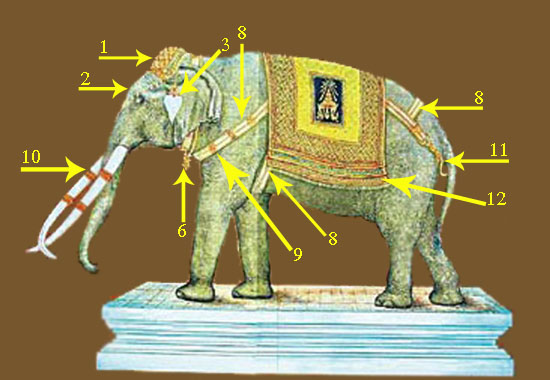
The ‘Gajabhorn’of Phra Sawet Adulyadejpahon
- Phapokkapong (ผ้าปกประพอง): The head-dress is similar in style to a Padma petal, the sacred lotus in Buddhism, and is made from Yiarabab fabric - the brocade, from India, has a red background with gold stripes.
- Takaikeawkudan or Ubakeawkudan (ตาข่ายแก้วกุดั่น or อุบะแก้วกุดั่น): The head-net is constructed in an isosceles pattern, made from Russian glass beads with golden strings.
- Poohoo (พู่หู): A pair of tassels decorate the elephant’s ears, and are made from yak fur.
- Phakumpoo (ผ้าคลุมพู่): The fabric covering the tassels is made from Yiarabab fabric in a pattern of six-pointed stars.
- Jongkonpoo (จงกลพู่): The golden tassel-head is similar in shape to a cone.
- Tamkor, Pannar and Panlung (ทามคอ พานหน้า and พานหลัง): The elephant girths adorning the elephant’s neck, back and tail are made from woven fabric covered in gold brocade connected by gold-covered steel rings.
- Taab or Taabtit (ตาบ or ตาบทิศ): The golden ornaments decorating Pannar and Panlung are in gem-decorated golden relief in the Thai flower form.
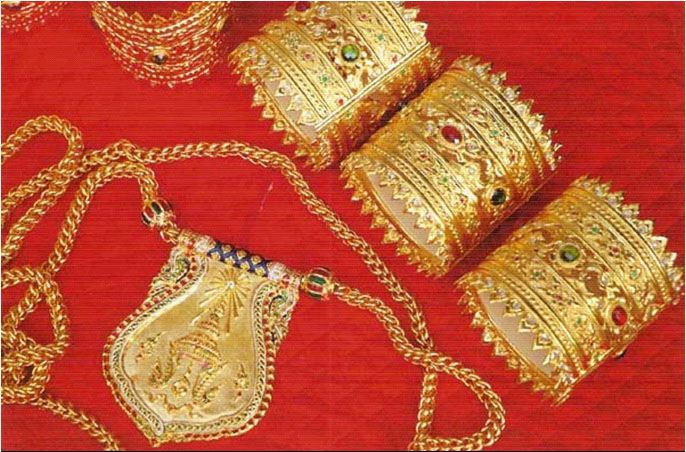
The Semagajabhorn, Soikor and Walainga of Phra Sawet Adulyadejpahon
- Semagajabhorn (เสมาคชาภรณ์): The pendant is similar to Sema - the boundary stones for the Thai Buddhist ordination hall (Phra Ubosot) - and these are akin to the shape of the leaves of the Bodhi tree. The centre is a relief of King Rama IX’s personal royal emblem, as seen in image 8.
- Soikor (สร้อยคอ): The golden mesh chain connects to both sides of the Semagajaphorn.
- Walainga or Sanubnga (วลัยงา or สนับงา): The golden rings adorn the elephant’s tusks, and are decorated with precious stones.
- Samaung (สำอาง): The rings connect to the elephant’s tail by the tail girths and are made of brass coated with gold.
The Panart or back’s cloth of Phra Sawet Adulyadejpahon
- Panart (พนาศ): The backcloth is rectangular and made from Yiarabab fabric. The centre has a yellow background which, in Thai, is the color of Monday, the day of King Rama IX’s birth, and is decorated with his personal royal emblem. The surrounding fabric has a red background with gold stripes.
This Gajabhorn is one example of the beautiful, meticulous and invaluable regalia made in the Ratthanakosin era and contains a total of 6 kilograms of gold.
Phra Sawet Adulyadejpahon died at the royal elephant hall in the Klaikangwol Palace, Prachuap Khiri Khan on April 3, 2010. Following the elephant's death, the king ordered the Bureau of the Royal Household to send the Gajabhorn to the Bureau of Grand National Treasure, within the Treasury department (part of the Ministry of Finance) on January 23, 2013 to be conserved and prepared for exhibition. The Gajabhorn is not only elephant’s regalia – it is one of only two sets of ornamentation made which represent the long reign and power of the king.
*Curator, the Grand National Treasure Exhibition Division, Bureau of Grand National Treasure
Based on:
Somsak Ritpakdee. (2013). The ‘Gajabhorn’ of Phra Sawet Adulyadejpahon: the ornaments of the first King Rama IX’s elephant. Retrieved June 17, 2013, from Pavilion of Regalia, Royal Decorations and Coins e-museum: http://emuseum.treasury.go.th/ (Thai Lauguage)
